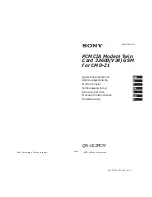
6 Commands
57
6.28
CWMoni
Default setting: 1
Parameter: 0 CW monitor tone disabled.
1 CW monitor tone enabled (TX).
2 CW monitor tone enabled (RX /TX).
This command has no function within the PTC-IIIusb and is just implemented to achieve
extensive compatibility with existing PC software
6.29
CWSpeed
Default setting: 160
Parameter: X 40... 1200, CW speed in LpM.
The
CWSpeed
command enables the CW speed to be set continuously between 40 and
1200 LpM (Letters per minute).
The CW speed applies to the CW ID as well as to the CW terminal.
6.30
CWTerm
Default setting: no
Parameter: X 40... 400, Start receiving speed in LpM.
The
CWTerm
command activates the CW terminal of the PTC-IIIusb. The actual speed
depends on the
CWSpeed
parameter. The keying takes place using the PTT line, as with
the
CWID
. The FSK line remains constant on the Mark frequency. The AFSK signal
amplitude is also keyed. The frequency for AFSK is defined by the
Center
command in
the
AUdio
After activating the CW terminal, characters from the keyboard, that can be translated
into Morse, are transmitted as Morse code by the PTC.
If an argument is entered, the decoder starts in the fix-speed-mode, that means that
automatic speed adaption is disabled. This is recommended for recording
commercial
CW
transmissions (weather report etc)., whose speeds are known. When nothing is input at the
keyboard, (and the transmit buffer is empty), then the CW terminal is in receive mode.
The actual receiving speed can be determined with the
SHow
command.
When a command shell be sent to the PTC, (e.g.
DD
) then the ESC character (refer to
chapter
) has to be sent first, as the PTC operates in
Converse
mode when
the CW terminal is active.
When the CW terminal is in use, the AMTOR prompt is displayed, though the
A
is
replaced by a
C
. As mode status (Status Level = 1) is shown RTTY, as the function of the
terminal in most respects resembles the RTTY module.
The demodulator uses the talked about technique of the Auto-Correlation filter in the
Audio-Menu (refer t chapter
). This enables even weak signals to be reliably
detected
without
tuning problems. (An ideal filter for a CW signal with a speed of 60
















































